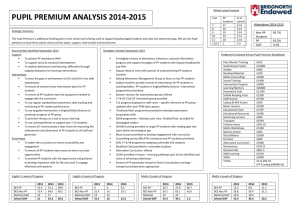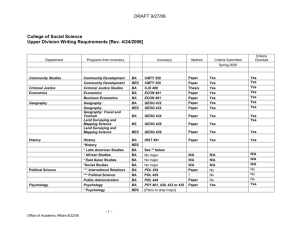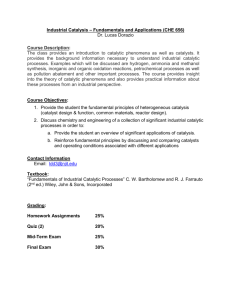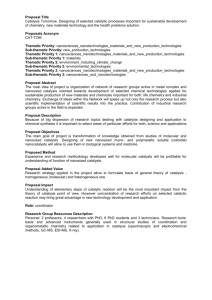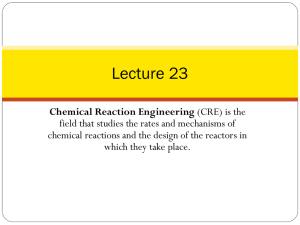A National Infrastructure for the Study of Catalysis ( )
advertisement
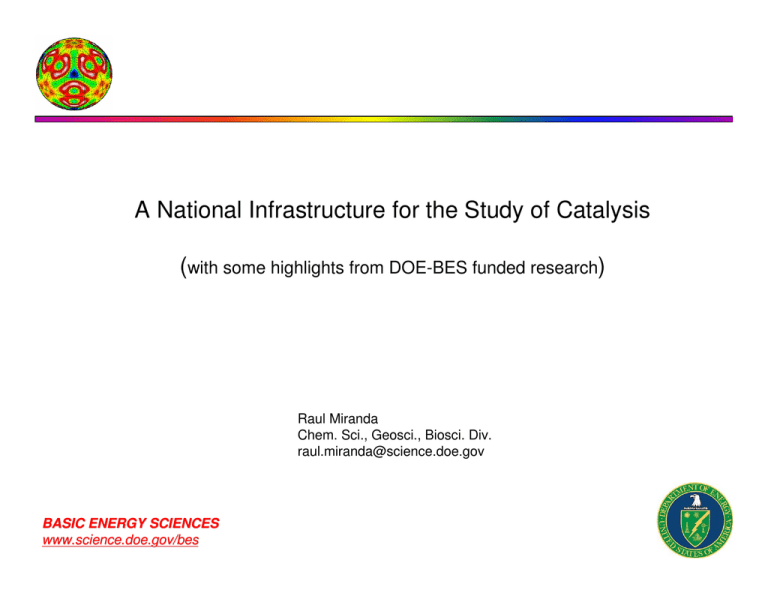
A National Infrastructure for the Study of Catalysis (with some highlights from DOE-BES funded research) Raul Miranda Chem. Sci., Geosci., Biosci. Div. raul.miranda@science.doe.gov BASIC ENERGY SCIENCES www.science.doe.gov/bes $24.3B – FY06 $1.23B $234M $1.2B $462M Enabling sciences Materials and molecular synthesis Physicochemical characterization Reactivity characterization Theory, modeling and simulation Systems integration (The following highlights are not meant to be comprehensive in coverage.) BASIC ENERGY SCIENCES www.science.doe.gov/bes Materials and molecular synthesis -DOE NSRCs (nanoscience research centers) -Carbon-based supramolecules: bowls and nanotubes (Larry Scott; Andrzej Sygula; Daniel Resasco) -Bimetallic clusters and metallic grids (Richard Crooks; Gabor Somorjai) -Elementary oxides and carbides (Zdenek Dohnalek; Michael G. White) -Complex oxides (Vadim Guliants) -Hybrid or functionalized oxides (Victor Lin; Harold Kung) -Semi-rigid porous frameworks (Ken Raymond; Omar Yaghi) BASIC ENERGY SCIENCES www.science.doe.gov/bes BES and BER Scientific User Facilities Environmental Molecular Sciences Lab Electron Microscopy Center for Materials Research Center for Nanoscale Materials Advanced Light Source Advanced Photon Source Intense Pulsed Neutron Source National Center for Electron Microscopy Center for Functional Nanomaterials National Synchrotron Light Source Molecular Foundry National Synchrotron Light Source-II Stanford Synchrotron Radiation Lab Spallation Neutron Source Linac Coherent Light Source Center for Nanophase Materials Sciences Combustion Research Facility Los Alamos Neutron Science Center Center for Integrated Nanotechnologies • 4 Synchrotron Radiation Light Sources • Linac Coherent Light Source & NSLS-II (PED or construction) • 4 Neutron Sources • 3 Electron Beam Microcharacterization Centers • 5 Nanoscale Science Research Centers (2 complete and 3 nearly complete) • 1 Special Purpose Center Shared Research Equipment Program High-Flux Isotope Reactor buckybowls: from corannulene to hemifullerene Progress made in coordination chemistry of transition-metal centers to polyaromatic hydrocarbons has produced families of buckybowls. Shown are two complexes of [Rh2(O2CCF3)4] with corannulene (C20H10). Larry Scott, Dalton Trans., 2005, 2969 - 2975 Properties: electron rich, porous layers Potential functions: -Li+ sponges -Molecular clips and tweezers -Etc. A. Sygula et al., Org. Lett. 2005: 1999-2001 Versatile SWNT Superstructures SWNT forest prepared by CO disproportionation (CVD, 1 atm) catalyzed by CoMo bimetallic clusters on silicon substrate CoMo/Si-wafer prepared by nanosphere lithography, and resulting hydrophobic towers of bundled SWNT Hybrid fullerene-SWNT prepared using Fe and CoMo catalysts Superhydrophobicity, as measured by wetting angle: Water/graphite: 86o, 2D SWNT: 86o, SWNT forest: 135o, SWNT tower: 180o Daniel Resasco, Nature Nanotechnology 2(3) 156-161 (2007) Aromatic Inorganic Clusters Dr. Lai-Sheng Wang, Zdenek Dohnalek and colleagues at the Pacific Northwest National Laboratory have found that aromaticity extends beyond organic rings to metal atoms rings and even, surprisingly, to anionic metal oxide clusters. While investigating the features that define transition metal oxide catalysts, which are active for many hydrocarbon oxidation reactions, Wang et al. mimicked the catalytic sites by means of molybdenum and tungsten oxide molecules charged with one or two additional electrons. They discovered spectroscopically that the singly or the doubly-charged M3O9 species (a most stable species), where M is molybdenum or tungsten, has delocalized electronic states typical of aromatics. Theoretical first-principles electronic structure calculations confirmed the delocalization of the additional electrons and explained the unusual stability of the anionic species. Moreover, they led to the hexagonal symmetry or ring structure shown in the figure. This is the first theoretical prediction and experimental observations of this phenomenon, a phenomenon that could have implications for the synthesis and reactivity of transition metal oxide clusters. L.-S. Wang, Angewandte Chemie International Edition 2005, 44, pp 1-5 C&EN 2005, 83, 83, pp. 48; and Nature 2005, 438, 438, pp. 261 Origin of Catalytic Behavior in Metal Oxides: A challenge Interest in transition metal oxide systems stems from their application in a number of important reactions involving partial oxidation of alcohols derived from biomass and oxidative dehydrogenation of hydrocarbons either to produce and store hydrogen or to produce valuable chemical intermediates. To simplify the complexity and understand the origin of reactivity in oxides, model systems are prepared and studied. The simplest approach has been to examine the chemistry of single crystal surfaces or, on the contrary, quasi-amorphous or polydispersed oxide clusters. For the first time, a collaborative team from Pacific Northwest National Laboratory (PNNL) and the University of Texas prepared monodispersed oxide clusters supported on another oxide. This unique approach involved direct sublimation from solid tungsten trioxide (WO3) and resulted in the successful stabilization of monodispersed cyclic trimers (WO3)3 on a well-characterized, single-crystal titanium oxide substrate (TiO2) (110). The (WO3)3 trimers were successfully imaged using scanning tunneling microscopy; their empty states resembled those of gas phase cyclic (WO3)3. Additional characterization efforts employed mass balance and x-ray photoelectron spectroscopy to determine the cluster mass, stoichiometry, and tungsten oxidation state. Preparation of such monodispersed, model systems allows for further exploration of their catalytic activity in an ensemble averaged manner. Ongoing studies have already shown that the (WO3)3 clusters are catalytically active toward formaldehyde polymerization and 2-butanol dehydration. Solid state quantum mechanical calculations provide a detailed understanding of the cluster electronic structure and binding to TiO2(110). Their catalytic activity is being investigated. Zdenek Dohnalek et al., Angew. Chem. Int. Ed. 45: 4786-89 (2006) Physicochemical characterization -DOE synchrotron, microscopy, NMR facilities -Structural dynamics -reconstruction (Eric Altman) -solid state reactions (Jonathan Hanson) -sintering and deactivation (Charles Campbell) -Metal catalytic sites (Wayne Goodman) -Oxidic, sulfidic, carbidic sites (Robert Schloegl; Henry Topsoe; Jingguang Chen) -Interfacial atoms (Judith Yang) BASIC ENERGY SCIENCES www.science.doe.gov/bes BES and BER Scientific User Facilities Environmental Molecular Sciences Lab NMR facility Electron Microscopy Center for Materials Research Center for Nanoscale Materials Advanced Light Source Advanced Photon Source Intense Pulsed Neutron Source National Center for Electron Microscopy Center for Functional Nanomaterials National Synchrotron Light Source Molecular Foundry National Synchrotron Light Source-II Stanford Synchrotron Radiation Lab Spallation Neutron Source Linac Coherent Light Source Center for Nanophase Materials Sciences Combustion Research Facility Los Alamos Neutron Science Center Center for Integrated Nanotechnologies • 4 Synchrotron Radiation Light Sources • Linac Coherent Light Source & NSLS-II (PED or construction) • 4 Neutron Sources • 3 Electron Beam Microcharacterization Centers • 5 Nanoscale Science Research Centers (2 complete and 3 nearly complete) • 1 Special Purpose Center Shared Research Equipment Program High-Flux Isotope Reactor Why do Catalysts Need Promoters? A dramatic enhancement of activity and selectivity of oxidation catalysts such as palladium metal is observed when the metal atoms are diluted with gold. These alloys catalyze a range of important energy-demanding or producing applications, from vinyl acetate synthesis to hydrogen fuel cells to pollution control. However, why gold promotes palladium is poorly understood and, in general, how catalytic promotion occurs is mostly unknown. Using the vinyl acetate synthesis from ethylene, oxygen and acetic acid as a model reaction, Professor D. Wayne Goodman at Texas A&M University found that the level of enhancement is determined by the way the palladium atoms are spatially arranged on the surface of the alloy. He concluded that only those surfaces that contain well dispersed pairs of palladium atoms display catalytic activities 40 times those of pure palladium metal. This particular arrangement is promoted by a very open type of gold surface, gold (100). Other arrangements are not optimal. For example, the closepacked gold (111) surface arranges palladium as single isolated atoms, and the best performance delivered was just 10 times that of pure palladium. To answer the question of why pairs of palladium atoms performed better than single atoms, he used various spectroscopic, C2H4 + ½ O2 + CH3COOH microscopy and chemical techniques to infer the CH2=CH—OCOCH3 + H2O distribution of atoms and chemical bonds. He discovered that the two main functionalities involved in this reaction (the vinyl group and acetate groups) must be brought within 3.3-4.1 angstrom of each other, which only the palladium pairs embedded in the gold (100) surface are able to do. D.W. Goodman et al. (Science, 2005 310: 291-293). Reactivity characterization -Operando kinetics (Israel Wachs) -Backbone motion and catalysis (Dorothee Kern) -Time-resolved dynamics (Nicholas Camillone III) -Chemistry in confined environments (Robert Bergman; Marek Pruski; Bruce Gates) -Ionic hydrogenation (Morris Bullock) -Electrochemical activation (Radoslav Adzic) -Extreme environments (T, P, E, B) (Lanny Schmidt) BASIC ENERGY SCIENCES www.science.doe.gov/bes Catalysis in Confinement: Aza-Cope Rearrangement Profs. R. Bergman and K. Raymond at the Lawrence Berkeley National Laboratory have demonstrated entropy-driven intramolecular rearrangements catalyzed by the constraints imposed by chiral nanovessels. These host molecules consist of M4L6 naphthalene-based self-assemblies with hydrophobic interiors and hydrophilic exteriors. The catalytic host was shown to accelerate the rearrangement of enammonium cation (B-1) to the iminium cation B-2, followed by hydrolysis to yield the unsaturated aldehyde B-3. The restricted space forces the substrate into reactive conformations, accelerating the rearrangement by up 850-fold. Bergman R., Raymond K., Angew. Chem. 43, 2 (2004). 1 0.95 starting material Free 0.9 Inhibited 27% cat. 0.85 40% cat. 0.8 0.75 0.7 0 1000 2000 3000 4000 5000 time [sec] Initial rates for different catalyst loadings: k27%cat. = 1.17 x 10-4 s-1; k40%cat. = 1.80 x 10-4 s-1; kuncat. = < 10-6 s-1 D. Fiedler, K. N. Raymond, R. G. Bergman, 2004 Single-Molecule Supported Catalyst Researchers have strived to synthesize hybrid catalysts that combine the advantages of highly selective homogeneous catalysts and highly stable and separable heterogeneous catalysts, in order to reduce the huge energy consumption associated with separating the products and the catalysts from the reaction mixtures. Thus they have pursued supported organometallic complexes that could be anchored on inorganic supports without the loss of catalytic activity or selectivity and with the gain of structural uniformity and integrity. Profs. James Haw at the University of Southern California and Bruce Gates at the University of California-Davis have recently provided the first structural and theoretical evidence of a mononuclear rhodium complex with ethylene ligands that is distributed molecularly and uniformly throughout the cages of zeolite Y. Molecular dispersion and structural uniformity could in principle prevent product degradation caused by secondary reactions and enhance catalytic site uniqueness and thus selectivity. This result, published as a coverpage article, is a significant contribution to the burgeoning field of surface organometallic chemistry. The picture shows the rotation of the ethylene ligands about the Rh+ center (green sphere). Haw, J., Gates, B., et al., Angewandte Chemie International Edition 2006, 45, 574-576 Electrocatalytic Activity of Platinum-Monolayer Alloys Ea In low-temperature fuel-cells, the cathodic oxygen reduction reaction (ORR) is very slow and critically dependent on the composition and structure of the platinum alloy electrodes. Adzic and Mavrikakis have demonstrated for the first time that Pt monolayers epitaxially grown on single crystal metal substrates possess higher activity than the best known electrodes, but with much less content of Pt. Investigation of the atomic and electronic structures of the Ptmonolayer alloys and the mechanism of the ORR led to a new discovery. The activity for the ORR displays a volcano-plot behavior with maximum for PtML/Pd(111). For this alloy, the Pt metal strain and thus the center of the d-band are such that the two critical steps – the 4-electron oxygen reduction and the hydrogen insertion–present an overall minimum in activation energy (fig. at top right). This work was carried out by R. Adzic at the Brookhaven National Laboratory (electrochemistry and surface chemistry), National Synchrotron Light Source (EXAFS, XANES), and by M. Mavrikakis (DFT calculations) at the U. Wisconsin, DOE-NERSC, NPACI and PNNL supercomputing centers. R. Adzic, M. Mavrikakis, et al., Angew. Chem. Int. Ed. (2005) 44: 2132-2135 E a (O 2O → 2 ) (O+ H→ OH ) Kinetic current from O2 reduction as a function of the binding energy of atomic O. Similar dependence is observed for kinetic current as a function of the d-band center relative to the Fermi level. Theory, modeling and simulation -National Facilities and Public Codes -Quantum chemistry (David Dixon) -Chemical kinetics simulation (Matthew Neurock) -Dissolution kinetics simulation (Perla Balbuena) -Extreme environments (E, P) (Andrew Rappe) -Beyond DFT – algorithm development (John Kitchin; Jens Norskov) BASIC ENERGY SCIENCES www.science.doe.gov/bes www.sc.doe.gov/ascr Mission: provide computational and networking tools that enable researchers in the scientific disciplines to analyze, model, simulate, and predict complex phenomena. Science areas: Applied Mathematics Computer Science Integrated Network Environments Facilities: NERSC: The National Energy Research Scientific Computing Center – at LBNL IBM SP3, 6,000 processors, 10 teraflops; in 2008 adding a Cray, 100 TFlps Leadership Computing Facility – at ORNL and ANL ORNL: Cray XT3 , 50-250 TFlps; ANL: IBM BlueGene/L 5 TFlps In 2007: BlueGene/P 100 TFlps; upgraded in 2008 to 250-500 TFlps Programs: Allocate CPU-h at NERSC, ORNL, ANL and PNNL for labs and universities SciDAC: Scientific Discovery through Advanced Computing - Centers for Enabling Technologies INCITE: Innovative and Novel Computational Impact on Theory and Experiment Multiscale Mathematics Initiative Public Software Packages for Molecular Modeling: PNNL: NWChem; Hondo Ames: Gamess Model Catalyst Theory: Predict kinetics, thermodynamics, structure, & spectroscopy Rate Theories Small, gas phase molecule Quantum statistical mechanics H3PO4 Quantum simulation methods Multiple timescale dynamics Basis sets Fast methods New accurate DFT methods New correlatio n methods Phase transitions Solvation & QM/MM Force fields Solid state Relativistic effects Electron transfer theory Interfacial & solution redox chemistry • Maintain accuracy by systematically eliminating approximations • Increase system size Scaling in Time and Space Time Theory Space Quantum dynamics Molecular dynamics Electronic structure Langevin Extended Langevin continuum, Lattice Boltzmann 1 fsec 1 psec 1 nsec 1 µsec 1 msec Molecular mechanics/dynamics Coarse-grained models, analogy, guesswork 0.1nm Ultrafast spectroscopy Optical, vibrational spectra Dielectric, mechanical relaxation Reaction kinetics 1 nm 10 nm 100nm 1µ Vibrational spectroscopy, nmr, x-ray, neutron, imaging Bragg reflectance nsom SEM, TEM Magnetic Resonance Experiment 10 µ Predicting the Stability of Nanocatalysts in Acidic Media Typical electrodes for polymeric-exchangemembrane fuel cells contain nanoparticles of platinum alloys in contact with the acidic medium of the electrolyte. Chemical stability and long term durability are two of the greatest technical challenges for both electrodes in hydrogen fuel cells, but are particularly so for the cathode where the oxygen reduction reaction occurs. Until now, the design of platinum alloy electrocatalysts has been guided primarily by empirical information. Recently, Professor Perla Balbuena at Texas A&M University described a theoretical approach involving density functional theory applied to clusters and slabs of model bimetallic alloys of platinum with iridium, palladium, rhodium, nickel, and cobalt. She modeled the interfacial chemistry, verified that the primary dissolution mechanism is electrochemical, and, for the first time, predicted the trends in the stability of the bimetallic nanoparticles. This fundamental understanding could greatly influence the future design of fuel cell electrodes. Z. Gu and P. Balbuena, J. Phys. Chem. A, Letters, published on the web on 7/22/2006 Figure 4. DDG (eV) of dissolution reactions of metal Pt vs Pt, Pd, Ni, Ir, Rh, and Co in PtPt, PtPd, PtNi, PtIr, PtRh, and PtCo alloy cathode catalyst based on M(H2O)62+ with B3LYP/Lanl2dz and 6-311++g-(d,p). Systems integration -Integrating across temporal and spatial domains -Process dynamics in catalysis (Dionisios Vlachos) -Solvation and catalysis (Conrad Zhang) -Contaminants - designing catalyst robustness (Jim Dumesic) -Hybrid chemical-bio reactors BASIC ENERGY SCIENCES www.science.doe.gov/bes APPENDIX BASIC ENERGY SCIENCES www.science.doe.gov/bes Department of Energy Federal Energy Regulatory Commission Under Secretary for Nuclear Security/ Administrator for Nuclear Security NNSA $9.2 B Departmental Staff and Support Offices Secretary Samuel Bodman $24.3 B FY 2006 Under Secretary for Science Inspector General Office of Economic Impact and Diversity Chief Financial Officer General Counsel Assistant Secretary for International Affairs Assistant Secretary for Environment, Safety and Health Under Secretary for Energy [Science] and Environment Assistant Secretary for Congressional & Intergovnm'tal Affairs Counterintelligence Intelligence Office of Security and Emergency Operations/ Chief Information Officer Office of Independent Oversight and Performance Assurance Office of Public Affairs Office of Policy Office of Management and Administration Office of Worker and Community Transition Office of Hearings and Appeals Contract Reform and Privatization Project Office Secretary of Energy Advisory Board Defense Nuclear Facilities Safety Board Liaison Assistant Secretary for Fossil Energy FE $598M Deputy Administrator for Defense Programs Deputy Administrator for Defense Nuclear Nonproliferation Deputy Administrator for Naval Reactors Director, Office of Science SC $3.6 B Assistant Secretary for Environmental Management EM $7.7 B Assistant Secretary for Energy Efficiency and Renewable Energy EERE $1.23B Nuclear En, Science & Tech NE $511M Office of Civilian Radioactive Waste Management RW $495M Power Marketing Administration Energy Information Administration Energy Programs are 10 % of DOE’s budget $3.6 B $234 M $1197 M $462 M Office of Basic Energy Sciences Patricia Dehmer, Director Mary Jo Martin, Administrative Specialist Materials Sciences and Engineering Division Harriet Kung, Director Christie Ashton, Program Analyst Ann Lundy, Secretary Scientific User Facilities Division $221 Pedro Montano, Director $279 M Materials and Engineering Physics X-Ray, Neutron, & Electron Scattering Facilities Harriet Kung, Acting Cheryl Howard, Prog. Asst. Helen Kerch Vacant, Prog. Asst. Structure & Composition of Materials Robert Astheimer Linda Blevins Richard Burrow Margie Davis F. Don Freeburn Kensley Rivera Karen Talamini Chemical Sciences, Geosciences, M and Biosciences Division Eric Rohlfing, Director Diane Marceau, Program Analyst Michaelene Kyler-King, Program Assistant Linda Cerrone, Program Support Specialist Condensed Matter Phys and Materials Chemistry X-Ray & Neutron Scat. Director's Office Staff $696 M Fundamental Interactions Molecular Processes and Geosciences Energy Biosciences Research Roger Klaffky Altaf (Tof) Carim Michael Casassa, Acting Robin Felder, Prog. Asst. John C. Miller Teresa Russ, Prog. Asst. Richard Greene, Acting Dennis Burmeister, Prog. Asst. Experimental Condensed Matter Physics Spallation Neutron Source (Construction) Atomic, Molecular, and Optical Science Jane Zhu Peter Tortorelli, ORNL James Horwitz Doug Finnemore, Ames Tom Brown Michael Casassa Catalysis and Chemical Transformation Raul Miranda Paul Maupin Michael Chen, ANL Plant Sciences Biochemistry and Biophysics Mechanical Behavior of Materials & Rad Effects Yok Chen John Vetrano Richard Wright, INL Theoretical Condensed Matter Physics Dale Koelling Randy Fishman, ORNL Jim Davenport Nanoscale Science Research Centers (Construction) Altaf (Tof) Carim Tom Brown Physical Behavior of Materials Materials Chemistry & Biomolecular Materials Refik Kortan Jeffrey Tsao, SNL Dick Kelley Aravinda Kini Synthesis & Processing Science Timothy Fitzsimmons Bonnie Gersten Daniel Friedman, NREL X-ray & Neutron Scattering Helen Kerch Helen Farrell, INL Engineering Research Timothy Fitzsimmons March 2007 Experimental Program to Stimulate Competitive Research (EPSCoR) Kristin Bennett Chemical Physics Separations and Analysis Gregory Fiechtner Frank Tully, SNL William Millman Larry Rahn, SNL Photochemistry & Radiation Research Mary Gress Mark Spitler, NREL Heavy Element Chemistry Instrument MIEs (SNS, LCLS, etc.) Computational and Theoretical Chemistry Tom Brown Richard Hilderbrandt Chemical Energy and Chemical Engineering Paul Maupin Linac Coherent Light Source (Construction) Tom Brown NSLS II Vacant Tom Brown IPA Detailee Detailee, 1/4 time, not at HQ AAAS Fellow Lester Morss Norman Edelstein, LBNL Geosciences Research Nicholas Woodward Patrick Dobson Marsha Bollinger, AAAS Richard Greene Michael Kahn, PNNL $25 M $37 M Chemical Sciences, Geosciences, and Biosciences Division Eric Rohlfing, Director Diane Marceau, Program Analyst Michaelene Kyler-King, Program Assistant Fundamental Interactions Photo- and BioChemistry Chemical Transformations Michael Casassa R. Felder, Prog. Asst. Richard Greene D. Burmeister, Prog. Asst. John Miller T. Russ, Prog. Asst. Atomic, Molecular, and Optical Sciences Solar Photochemistry Vacant A Ultrafast Chemical Sciences Vacant 08-3 Gas-Phase Chemical Physics Vacant 08-2 Condensed-phase and Interfacial Mol. Sci. Gregory Fiechtner Vacant A Photosynthetic Systems Vacant 08-4 Physical Biosciences Vacant 08-1 Catalysis Science Raul Miranda Paul Maupin Heavy Element Chemistry Lester Morss Separations and Analysis William Millman Geosciences Nicolas Woodward Computational and Theoretical Chemistry Richard Hildebrandt A 08-# FY07 position “in progress” FY08 position; ordered FY 2008 President’s Request for BES = $1,498,497K Design and Construction (LCLS, NSLS-II) PE TTR P,G BIR/S P G S Materials Sciences Research Neutron Scattering Facilities Operation Chemistry, Biosciences, Geosciences Research Synchrotron Light Source Facilities Operation Major Items of Equipment Electron Beam Centers Combustion Research Facility Nanoscale Science Research Centers 31 BES Scientific User Facilities Electron Microscopy Center for Materials Research Center for Nanoscale Materials Advanced Light Source Advanced Photon Source Intense Pulsed Neutron Source National Center for Electron Microscopy Center for Functional Nanomaterials National Synchrotron Light Source Molecular Foundry National Synchrotron Light Source-II Stanford Synchrotron Radiation Lab Spallation Neutron Source Linac Coherent Light Source Center for Nanophase Materials Sciences Combustion Research Facility Los Alamos Neutron Science Center Center for Integrated Nanotechnologies • 4 Synchrotron Radiation Light Sources • Linac Coherent Light Source & NSLS-II (PED or construction) • 4 Neutron Sources • 3 Electron Beam Microcharacterization Centers • 5 Nanoscale Science Research Centers (2 complete and 3 nearly complete) • 1 Special Purpose Center Shared Research Equipment Program High-Flux Isotope Reactor Basic Energy Sciences Advisory Committee study in 2002-3 set the path for current BES investments RECOMMENDATION: Considering the urgency of the energy problem, the magnitude of the needed scientific breakthroughs, and the historic rate of scientific discovery, current efforts will likely be too little, too late. Accordingly, BESAC believes that a new national energy research program is essential and must be initiated with the intensity and commitment of the Manhattan Project, and sustained until this problem is solved. February 2003 33 Research for a Secure Energy Future Supply, Carbon Management, Distribution, Consumption Decision Science and Complex Systems Science Carbon Energy Sources Carbon Management No-net-carbon Energy Sources Distribution/ Storage Energy Consumption Energy Conservation, Energy Efficiency, and Environmental Stewardship Coal Petroleum CO2 Sequestration Geologic Nuclear Fission Electricity Production & Grid Transportation Nuclear Fusion Electric Storage Buildings Renewables Hydrogen Industry Terrestrial Natural Gas Oil shale, tar sands, hydrates,… Oceanic Carbon Recycle Global Climate Change Science Hydropower Biomass Geothermal Wind Solar Ocean Alternate Fuels The Basic Research Needs Worshops: Basic Research in Support of the DOE Missions Basic Research Needs to Assure a Secure Energy Future BESAC Workshop, October 21-25, 2002 The foundation workshop that set the model for the focused workshops that follow. Basic Research Needs for the Hydrogen Economy BES Workshop, May 13-15, 2003 Basic Research Needs for Solar Energy Utilization BES Workshop, April 18-21, 2005 Basic Research Needs for Superconductivity BES Workshop, May 8-10, 2006 Basic Research Needs for Solid-state Lighting BES Workshop, May 22-24, 2006 Basic Research Needs for Advanced Nuclear Energy Systems BES Workshop, July 31-August 3, 2006 Basic Research Needs for the Clean and Efficient Combustion of 21st Century Transportation Fuels BES Workshop, October 30-November 1, 2006 Basic Research Needs for Geosciences: Enhancing 21st Century Energy Systems BES Workshop, February 21-24, 2007 Basic Research for Electrical Energy Storage BES Workshop, April 2-4, 2007 Basic Research Needs for Materials Under Extreme Conditions BES Workshop, June 11-13, 2007 Basic Research Needs in Catalysis for Energy BES Workshop, August 6-8, 2007 All reports available at: http://www.sc.doe.gov/bes/reports/list.html 35 Basic Research Needs in Catalysis for Energy Workshop: August 6-8, 2007, N. Bethesda Marriott Chairs: Alexis T. Bell Bruce C. Gates Douglas Ray (UC Berkeley) (UC Davis) (PNNL) Charge to the Workshop: Identify the basic research needs and opportunities in catalytic chemistry and materials that underpin energy conversion or utilization, with a focus on new, emerging and scientifically challenging areas that have the potential to significantly impact science and technology. The report ought to uncover the principal technological barriers and the underlying scientific limitations associated with efficient processing of energy resources. Highlighted areas must include the major developments in chemistry, biochemistry, materials and associated disciplines for energy processing and will point to future directions to overcome the long-term grand challenges in catalysis. A report should be published by November 2007. FY2007/2008 Research Initiatives in BES Instrumentation Basic research for solar energy utilization Basic research for the hydrogen fuel initiative Basic research for advanced nuclear energy systems ~ $20 M $34.1 M + $17.5 M $12.4 M FY2007 Appropriation 0 $8 M $4 M 0 Additional funding in FY 2008 Request 0 + $5.9 M + $9.5 M 0 ~ $20 M $40 M $27 M $12.4 M Solicitation: Funding in FY 2007 Request Total funding in FY2008 Request FY 2007 Congressional Budget released February 6, 2006 Announcement of intent to issue solicitations February 16, 2006 Posting solicitation on SC website March 7, 2006 March 21, 2006 April 20, 2006 October 12, 2006 May 17, 2006 106 preproposals June 5, 2006 656 preproposals July 6, 2006 502 preproposals Nov. 22, 2006 209 preproposals PIs notified of preproposal decisions June 30, 2006 59 encouraged August 11, 2006 346 encouraged Sept. 12, 2006 249 encouraged January 5, 2007 126 encouraged Full proposal deadlines August 30, 2006 58 received Nov. 14, 2006 309 received Dec. 12, 2006 229 received March 14, 2007 FY2007 award announcements (approx) none Mid May 2007 Mid May 2007 none FY2008 award announcements (pending appropriation) Nov 2007? Nov 2007? Nov 2007? Nov 2007? Preproposal deadlines U.S. Department of Energy Office of Science Office of Biological & Environmental Research Climate Change Research Environmental Sciences Life and Medical Sciences Life Sciences: Provide the fundamental scientific understanding of plants and microbes necessary to develop new robust and transformational basic research strategies for producing biofuels, cleaning up waste, and sequestering carbon. Climate Change Research: Deliver improved scientific data and models about the potential response of the Earth’s climate and terrestrial biosphere to increased greenhouse gas levels for policy makers to determine safe levels of greenhouse gases in the atmosphere. Environmental Remediation: Provide sufficient scientific understanding such that DOE sites would be able to incorporate coupled physical, chemical and biological processes into decision making for environmental remediation and long-term stewardship. GTL program: genomic data and high-throughput technologies for studying the proteins encoded by microbial and plant genomes. The goal is to understand fundamental biological processes and how living systems operate. genomicsgtl.energy.gov Genomics:GTL Roadmap: a predictive understanding of microbial communities for applications in energy, remediation, and global carbon cycling and sequestration. Breaking the Biological Barriers to Cellulosic Ethanol Plant Feedstock Genomics for Bioenergy DOE-OBER and the U.S. Department of Agriculture (USDA) $8.3 M – 11 grants – 2007/8- to develop cordgrass, rice and switchgrass Research Centers: developing the science for biofuels production; energy-related microbial and plant systems; cellulosic ethanol, but also potentially biodiesel, biofuels for aviation, hydrogen, and methane. Each Center: $125 M over 5 years. www.sc.doe.gov/ascr Mission: provide computational and networking tools that enable researchers in the scientific disciplines to analyze, model, simulate, and predict complex phenomena. Science areas: Applied Mathematics Computer Science Integrated Network Environments Facilities: NERSC: The National Energy Research Scientific Computing Center – at LBNL IBM SP3, 6,000 processors, 10 teraflops; in 2008 adding a Cray, 100 TFlps Leadership Computing Facility – at ORNL and ANL ORNL: Cray XT3 , 50-250 TFlps; ANL: IBM BlueGene/L 5 TFlps In 2007: BlueGene/P 100 TFlps; upgraded in 2008 to 250-500 TFlps Programs: Allocate CPU-h at NERSC, ORNL, ANL and PNNL for labs and universities SciDAC: Scientific Discovery through Advanced Computing - Centers for Enabling Technologies INCITE: Innovative and Novel Computational Impact on Theory and Experiment Multiscale Mathematics Initiative Public Software Packages for Molecular Modeling: PNNL: NWChem; Hondo Ames: Gamess Selectivity of Encapsulated Aldehyde C-H Activation Reactions Aldehyde Reactants and Organometallic Products Organometallic Reactant + Me Cp*(L)Ir MeCHO H2O [Ir +] 75°C EtCHO Me [Ir+] CO nPrCHO Et [Ir+] CO nPr i-PrCHO CO PhCHO [Ir+] [Ir+] [Ir+] CO nBuCHO CO Ph CO Not encapsulated + Me Cp*(L)Ir H2O [Ir+] 75°C Me CO + [Ir ] Et CO [Ir+ ] nPr No Reaction [Ir+ ] CO CO Encapsulated = [Ir+] = Ir + PMe3 D. Leung, K. N. Raymond, R. G. Bergman, 2003-4 No Reaction Intrinsic Motions of Proteins Underlie Catalysis Static pictures of protein structures (typically derived from x-ray crystallography) are so prevalent that one usually forgets that they are dynamic molecular machines. Characterizing the intrinsic motions of enzymes is necessary to fully understand how they work as catalysts. Prof. Dorothee Kern of Brandeis University has quantitatively determined the structural dynamics of cyclophilin A (CypA) in the microsecond to millisecond timescale both while the enzyme is involved in the catalytic isomerization of prolyl peptide bonds, and when it is free in solution. She correlated specific conformational changes, flexional modes in the protein backbone, and motions of residues, with the kinetics of the catalytic cycle, and she made a remarkable discovery. Contrary to the belief that conformational changes are coincident with or facilitated by the binding of the reacting substrate to the enzyme, the protein motion between conformational sub states occurs a priori with modes that are intrinsic to the structure and are determined by the amino acid sequence. That is, the protein samples the conformational sub states before the ligands bind. Catalytically active proteins evolve a set of sub states that are critical for the catalytic function. Kern, D., et al., Nature 438, 117-121 (2005) Quantum Systems with 104-105 Atoms. 0.1 nm 1 nm 10 nm 100 nm 1 µ Length scale Gaussian MO / DFT & Plane wave DFT Self-Consistent-Charge DF TightBinding Classical Potential MD Quasi-Continuum Structure Kinetic Monte Carlo & Lattice Boltzmann Simulations Modeling And Simulations Tools for the Nanoscale Ab-Initio Design of Near-Surface Alloys for Hydrogen-Bearing Catalysts The rational design of pure and alloy metal catalysts from fundamental principles has the potential to yield catalysts of greatly improved activity and selectivity or totally novel catalytic properties. In near-surface alloys, a solute metal is present near the surface of a host metal in concentrations different from the bulk. Such nanostructures possess unique electronic properties that in turn affect their surface catalytic properties. M. Mavrikakis used density functional theory calculations to discover a new class of alloys that can yield superior catalytic behavior for hydrogen-related reactions. Some of those alloys, e.g., Ni/Pt(111) and V/Pd(111), bind atomic hydrogen (H) as weakly as the noble metals (Cu, Au) while, at the same time, dissociate H2 much more easily. This unique behavior may permit those alloys to serve as low-temperature, highly selective catalysts for hydrogen fuel cells and for hydrogen storage. Manos Mavrikakis et al., University of Wisconsin-Madison M. Mavrikakis et al., Nature Materials (2004) (3: 810–815) H2 dissociation on near-surface alloys
